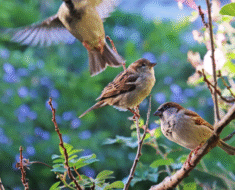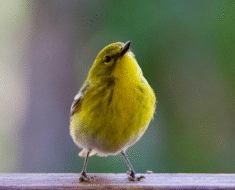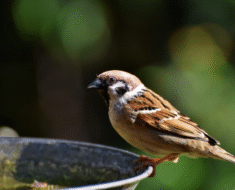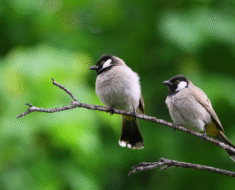
If you’ve ever been out walking near a stream in spring, and caught a glimpse of a little yellow-bellied bird darting between shrubs—chances are, you had a close encounter with the elusive MacGillivray’s Warbler. And if you didn’t know it then, well… you’re not alone. These birds are shy. They move fast. And frankly? Most people walk right past them without realizing they just brushed against one of nature’s more mysterious songbirds.
Today, we’re diving into this underrated little warbler’s life—where it hides, why it sings, what it eats, and what makes it so darn fascinating. You’ll learn how to spot it, how to appreciate its role in nature, and why ornithologists still get a little giddy when they talk about this bird.
Key Takeaways: What You’ll Learn About the MacGillivray’s Warbler
- Where MacGillivray’s Warbler lives and migrates through the year
- What sets it apart from similar-looking warblers
- How its behavior and song can help you find it
- Why scientists still study this bird—and what it teaches us about habitat conservation
- Tips to possibly spot one on your next hike
Meet the MacGillivray’s Warbler: Who Is This Bird, Really?
The MacGillivray’s Warbler (Geothlypis tolmiei) is a small, New World warbler that’s often found in thick shrubs, especially near water. Named after 19th-century Scottish naturalist William MacGillivray, this bird has an olive-green back, a bright yellow belly, and a distinctive gray hood that covers its head and throat.
Size & Features
- Roughly 4.3 to 5.5 inches long
- Weighs just 0.3 to 0.5 ounces
- Males have a prominent white eye arc (which looks like “spectacles”)
- Females are duller in color and lack the bold contrast
It looks pretty similar to the Mourning Warbler, and some birders honestly still confuse the two. But here’s the trick: MacGillivray’s is a bit shier and prefers higher altitudes during breeding season.
Where to Find One: Range, Habitat, and Migration
This warbler breeds in the mountainous western parts of North America, from coastal Alaska down to parts of California and New Mexico. In the fall, it migrates to Central America, with many overwintering in Mexico, El Salvador, and Guatemala.
Preferred habitats include:
- Dense thickets and underbrush
- Forest edges and post-burn regrowth areas
- Riparian corridors (areas near rivers and streams)
If you’re hiking in Montana or Idaho in late spring or early summer, listen for its sharp, choppy song from low shrubs or willows.
According to the Cornell Lab of Ornithology, these birds are incredibly habitat-specific—meaning they’ll only show up where conditions are just right.
The Song That Gives It Away
Spotting a MacGillivray’s Warbler visually is tough—they skulk through dense cover and rarely sit still. But they have a unique, recognizable song. It’s a fast, buzzy series of notes that usually starts strong and then tapers off. Think: jeet jeet jeet jeet…chewee chew.
A birding tip? If you’re trying to differentiate it from the Mourning Warbler by sound, MacGillivray’s warbler has more pronounced breaks between phrases and a higher pitch.
Diet: What Fuels This Feathered Machine?

Like many warblers, the MacGillivray’s diet is primarily insect-based. Its menu includes:
- Caterpillars
- Spiders
- Beetles
- Aphids
- Mosquitoes (yes, they do us a favor!)
During migration, they may also snack on berries and small fruits, especially when insects are scarce. Their agile foraging helps keep pest populations in check—a reminder that even tiny birds play a big role in ecosystem health.
Breeding and Nesting Behavior
MacGillivray’s Warblers are secretive nesters, which makes studying them a bit tricky. Nests are typically built low to the ground, hidden in thick shrubs or among reeds.
Nesting facts:
- The female builds the cup-shaped nest alone
- Usually lays 3–5 eggs per clutch
- Incubation lasts about 12 days
- Both parents help feed the chicks after they hatch
If you’re curious about nesting habits of similar birds, you might enjoy our post on Sparrow Nesting Habits: What You Should Know.
Why This Bird Still Intrigues Scientists
Despite its small size and modest looks, the MacGillivray’s Warbler is a favorite of researchers. Why? Its behavior gives clues about:
- Climate change: As temperatures rise, their breeding range is shifting northward.
- Habitat disturbance: They’re sensitive to changes in underbrush density, making them excellent indicators of forest health.
- Migration tracking: With geolocator tags, scientists have mapped their long journeys—sometimes over 3,000 miles one way.
A 2022 study published by The Condor: Ornithological Applications even noted population declines in some parts of their range, largely due to habitat loss from development and wildfires.
How to Spot One in the Wild (Without Losing Your Mind)
Let’s be honest: tracking down a MacGillivray’s Warbler in dense shrubs isn’t the easiest task. But here’s what helps:
- Go early – They’re most vocal just after sunrise
- Stay still – Movement scares them easily
- Learn the call – Let your ears do the spotting
- Check near water – Especially shaded stream banks
If you’re trying to ID multiple birds on your hike, you may also want to read How to Identify a Common Crossbill in the Wild? to sharpen your skills.
Fun and Lesser-Known Facts

Let’s take a breath and throw in a few fun facts:
- They molt twice a year—once before and once after migration
- The oldest recorded MacGillivray’s Warbler was 7 years and 11 months old
- They’ve been spotted as far east as Maine during migration mishaps
- They’re part of the genus Geothlypis, which means “ground warbler”—fitting, since they often forage near the forest floor
Why We Should Care About MacGillivray’s Warbler
You might be thinking—”It’s just one little bird.” But the truth is, species like the MacGillivray’s Warbler are like canaries in the coal mine. When their numbers drop or their ranges shift, it’s a sign that something bigger is changing in the environment.
Conservation groups use data from this species to monitor the health of forest ecosystems. Protecting warblers helps protect countless other species that share their habitat.
What You Can Do
Here are a few small steps to support birds like the MacGillivray’s Warbler:
- Support reforestation projects and habitat conservation
- Reduce pesticide use in your garden (those bugs are bird food!)
- Keep cats indoors—they kill millions of songbirds every year
- Report sightings through platforms like eBird
Even if you’re not a “birder,” your observations matter. Citizen science is a growing movement—and it’s surprisingly fun.
Conclusion: A Bird Worth Knowing
MacGillivray’s Warbler might not be the flashiest bird out there, but its quiet presence tells a rich story. A story of migration, survival, and the importance of wild places. It’s one of those birds you appreciate more the second time you see it—once you know what you’re looking for.
So the next time you’re near a dense, leafy streambed and hear a sharp, buzzing song? Pause. Wait. You might just get lucky.
And if this article helped you learn something new, share it with someone who loves nature as much as you do. Who knows—maybe they’ll become a warbler fan too.
FAQ (Schema-Ready)
What does a MacGillivray’s Warbler look like?
The MacGillivray’s Warbler has a gray hood, olive-green back, and bright yellow belly. Males show distinct white eye-arcs, while females appear more muted.
Where can I find MacGillivray’s Warbler in North America?
They breed in the western U.S. and Canada—especially in mountain shrublands—and migrate to Central America for the winter.
How do you tell the difference between MacGillivray’s and Mourning Warblers?
MacGillivray’s have broken white eye-rings and prefer higher elevations. Their song also has more separated phrases compared to the Mourning Warbler.
Are MacGillivray’s Warblers endangered?
They are not officially endangered, but some local populations are in decline due to habitat loss and climate change effects.





